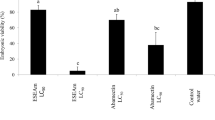Abstract
Bifenazate is a novel carbazate acaricide discovered by Uniroyal Chemical (now Chemtura Corporation) for the control of phytophagous mites infesting agricultural and ornamental crops. Its acaricidal activity and that of its principal active metabolite, diazene, were characterized. Bifenazate and diazene had high toxicity and specificity both orally and topically to all life stages of Tetranychus urticae and Panonychus citri. Acute poisoning was observed with no temperature dependency. No cross-resistance was found to mites resistant to several other classes of acaricides, such as tebufenpyrad, etoxazole, fenbutatin oxide and dicofol. Bifenazate remained effective for a long time with only about a 10% loss of efficacy on T. urticae after 1 month of application in the field. All stages of development of the predatory mites, Phytoseiulus persimilis and Neoseiulus californicus, survived treatment by both bifenazate and diazene. When adult females of the two predatory mite species were treated with either bifenazate or diazene, they showed a normal level of fecundity and predatory activity in the laboratory, effectively suppressing spider mite population growth. Even when the predators were fed spider mite eggs that had been treated previously with bifenazate, they survived. These findings indicate that bifenazate is a very useful acaricide giving high efficacy, long-lasting activity and excellent selectivity for spider mites. It is, therefore, concluded that bifenazate is an ideal compound for controlling these pest mites.

Similar content being viewed by others

References
Abbott WS (1925) A method for computing the effectiveness of an insecticide. J Econ Entomol 18:265–267
Amano H, Ishii Y, Kobiri Y (2004) Pesticide susceptibility of two dominant phytoseiid mites, Neoseiulus californicus and N. womersleyi, in conventional Japanese fruit orchard (Gamasina: Pyhtoseiidae). J Acarol Soc Jpn 13:65–70
BioStat (2007) Statistical Software. AnalystSoft, Vancouver, BC, Canada
Dekeyser MA, McDonald PT (1994) Insecticidal phenylhydrazine derivatives. US Patent 5,367, 093, 1994
Dekeyser MA, McDonald PT, Angle Jr GW (1994) Synthesis and miticidal and insecticidal activities of biphenylhydrazine carboxylates. J Ag Food Chem 42:1358–1360
Dekeyser MA, McDonald PT, Moore RC (1996) D2341-A novel agent to control spider mites. Proceedings of the British Crop Protection Conference—Pests and Diseases: 487–492
Dekeyser MA (2005) Review: acaricide mode of action. Pest Manag Sci 61:103–110
Grosscurt AC, Avella L (2005) Bifenazate, a new acaricide for use on ornamentals in Europe and Africa. Proceedings of the BCPC Int. Congress—Crop Science and Technology, pp 49–56
Hassan SA (1992) Guidelines for testing the effects of pesticides on beneficial organisms: description of test methods. Bull. IOBC/WPRS 15:18–39
IRAC (2007) Mode of action structure poster. http://www.irac-online.org/
Kim SS, YOO SS (2002) Comparative toxicity of some acaricides to the predatory mites, Phytoseiulus persimilis and the two-spotted spider mite, Tetranychus urticae. Biocontrol 47:563–573
Kyomura N, Fukuchi T, Kohyama Y, Motojima S (1990) Biological characteristics of new acaricide MK-239. British Crop Protection Conference—Pests and Diseases 1:55–62
Mittler TE (1988) Application of artificial feeding techniques for aphids. In: Minks AK, Harrewijn P (eds) Aphids: their biology natural enemies and control, vol 2B. Elsevier, Amsterdam, pp 145–171
Pree DJ, Whitty KJ, Van Driel L (2005) Baseline susceptibility and cross resistances of some new acaricides in the European red mite, Panonychus ulmi. Exp Appl Acarol 37:115–171
Rhodes EM, Liburd OE, Kelts C, Rondon SI et al (2006) Comparison of single and combination treatments of Phytoseiulus persimilis, Neoseiulus californicus, and acramite (bifenazate) for control of two-spotted spider mites in strawberries. Exp Appl Acarol 39:213–225
US/EPA (2003) Bifenazate http://www.epa.gov/fedrgstr/EPA-PEST/2003/January/Day-15/p850.htm
Van Leeuwen T, Van Pottelberge S, Tirry L (2005) Comparative acaricide susceptibility and detoxifying enzyme activities in field-collected resistance and susceptible strains of Tetranychus urticae. Pest Manag Sci 61:499–507
Van Leeuwen T, Tirry L, Nauen R (2006) Complete maternal inheritance of bifenazate resistance in Tetranychus urticae Koch and its implication in mode of action considerations. Insect Biochem Mol Biol 36:869–877
Acknowledgement
The authors thank many other researchers from Nissan Chemical Industries, Ltd. who have participated in the bifenazate project.
Author information
Authors and Affiliations
Corresponding author
Rights and permissions
About this article
Cite this article
Ochiai, N., Mizuno, M., Mimori, N. et al. Toxicity of bifenazate and its principal active metabolite, diazene, to Tetranychus urticae and Panonychus citri and their relative toxicity to the predaceous mites, Phytoseiulus persimilis and Neoseiulus californicus . Exp Appl Acarol 43, 181–197 (2007). https://doi.org/10.1007/s10493-007-9115-9
Received:
Accepted:
Published:
Issue Date:
DOI: https://doi.org/10.1007/s10493-007-9115-9



